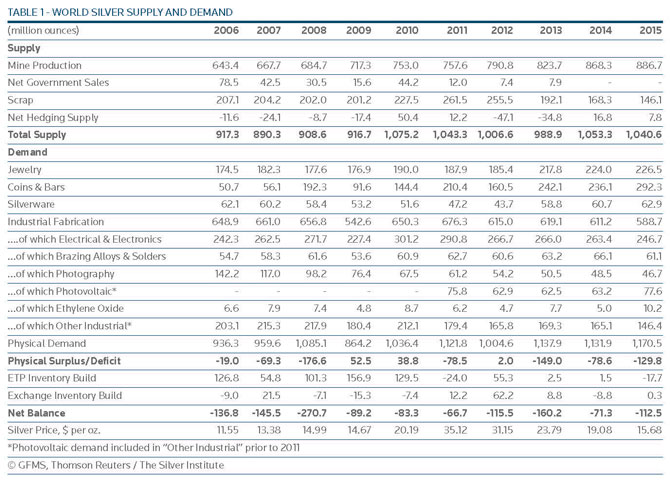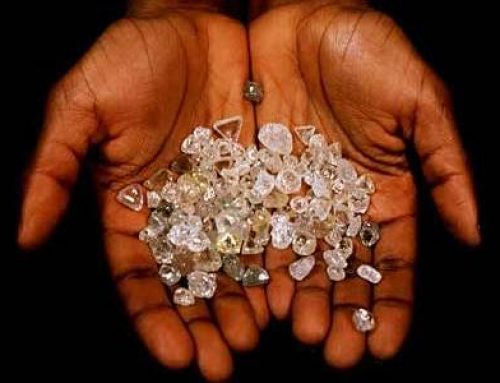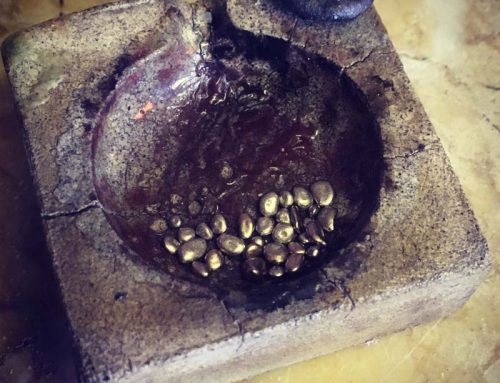Recycled Gold Jewelry – How ethical is it really?
The gap between fact and fiction, ethical claim and counter-claim in the jewelry profession is very confusing for the conscientious jewelry customer. In this article, award-winning ethical and fair trade jewelers Marc Choyt and Greg Valerio bring their pioneering experience and wisdom to the question,
‘Does buying recycled gold jewellery make a social and environmental difference to our world?’
We hope that you will agree with us that the purchase of truly ethical jewelry and gold wedding rings should empower grassroots economic development, make a positive contribution to environmental restoration and support full traceability and transparency in the supply chain.
When it comes to filling the ethical void in jewelry, there has been a rush in the last decade of well intentioned ethical practices targeted at improving the appearance of the profession. The use of branded recycled metals is now at the top of the list of actions that budding ethical jewelry brands have adopted. Jewelry brands and metal suppliers claim a strong green ethical message around the phrase ‘100% recycled’. Recycled gold, they claim, will reduce primary mining, that in turn makes a real difference to the environment. Can these claims be substantiated?
From the outset we wish to be clear that we believe using 100% recycled metals in jewelry is preferable to using conventional large-scale untraceable gold. Yet we hold the opinion that it has a slight impact on ethical performance within the jewelry and broader metal trade. The 6 points below will explain why.
6 observations about recycled gold jewelry.
1. Jewelers have always recycled their metal.
Recycled gold is nothing new. The jewelry profession has recycled its metal since artisans first started crafting gold and silver adornment some 5000 years ago. The process for scrapping gold and silver (cleverly re-branded recycling) is standard practice within the industry. Reflective Images is a traditional design led goldsmith jewelry company designing and crafting jewelry to customers unique desires. All of our goldsmiths will tell you (and this is repeated the world over) that no jeweler worth their salt throws away scrap, they recycle the metal value back through the refiner or bullion house. In all cases (with less than a handful of notable exceptions) once that metal is scrapped it is then blended (a process called mass balancing) with fresh sources of metal. What then comes to market is a mixture of recycled and new metal. If the gold or silver jewelry you then buy is not verified and audited as 100% post-consumer waste/scrap, then there is no guarantee that what you are buying is indeed recycled.
2. Recycled gold and silver does not reduce primary mining.
What is important to recognise is that over the last 10 years; the period when recycled gold jewelry claims have become prominent in the profession, the average annual production of newly mined gold has remained constant at 4,000t per annum.¹ The jewelry brands that claim buying recycled gold rings will ‘alleviate the devastating environmental impacts of gold mining’ are simply not rooting their marketing claims in the facts.
Silver as a case study.
As the GFMS (Gold Fields Mineral Services) table below demonstrates, silver coming to market does so through a number of other primary mined commodities. Silver is the principle by-product of gold, copper, lead and zinc mining. In fact only 28% of silver that hit the world market in 2008 was from primary silver mines. The rest (72%) came through these secondary channels.
Silver Output by Source Metal
| (millions of ounces) | |||||
| 2007 output | % of total | 2008 output | % of total | % change | |
| Primary | 194.1 | 29% | 191.2 | 28% | -1% |
| Gold | 60.7 | 9% | 76.7 | 11% | 3% |
| Lead/Zinc | 234.9 | 35% | 249.9 | 37% | 6% |
| Copper | 171.3 | 26% | 159.6 | 23% | -7% |
| Other | 3.3 | 0% | 3.6 | 2% | 9% |
| Total | 664.2 | 680.9 | 4% |
Source: GFMS
When added to the following production numbers for overall silver output from the table below we will see a steady annual increase in primary mined production of silver. This means increased demand for silver drives up the mining for other metal commodities.
However, recycled (scrap) demands have fallen, where as, primary mined production has increased in the last 10 years. Jewelry demand has also risen year on year, whilst recycling rates have fallen.
Very simply we can deduce that using recycled metals in jewelry does not mitigate the huge ecological or social problems that mining creates every year. To claim this is simply untrue and green washing. Jewelers who make these claims clearly lack a basic grasp of the complexities of the relationship between the mine and the market.
3. Not all recycled metal is a good news story.
As mentioned, unless recycled precious metal jewelry has independent verification, consumers simply will not know where the metal has come from. A famous scandal in 2014 featuring a Dubai refinery is the perfect storm to illustrate this. A global auditor caught the refinery buying; 4 tonnes of gold painted silver, buying untraceable gold for cash, dealing with suppliers in conflict regions of the world, as well as the usual scrap gold buying. As one of the biggest refineries in the world this material found its way into the global jewelry supply chain.
Annie Dunnebacke, from Global Witness said, ‘Refiners – those who melt the gold down into bars or other forms – are the choke point in the supply chain’.
Dubai has been cited in reports by Global Witness and the United Nations as a big destination for conflict gold, and when this conflict gold has been melted down with scrap gold and sold as recycled there is no way of proving provenance.
Untraceable gold comes from conflict, smuggled, criminal money laundering and other illegal sources. Once smelted through a refinery gold is traditionally untraceable. Consumers should very wary of recycled claims that are not verifiable.
4. Recycled gold jewelry has no social or economic benefit for exploited mining communities, the source is a refinery.
The question then arises which refinery and where? The bulk of jewelry sold in shopping malls across the USA or high street brands in the UK, is manufactured in China. Gold procured by these manufacturing plants through Chinese refineries offer no disclosure of source. All recycled gold jewelry will do is make the unaccountable & non-transparent refinery more prosperous and continue to create the economic conditions that demands more gold from conflict sources.
Recycled gold jewelry has no positive impact on the horrors of child bonded labour, economic exploitation, environmental degradation through cyanide or mercury use, resultant deforestation and the health and safety risks faced by gold mining communities across the world. All it does is avoid the issues by making the refinery the source of gold. Given that over 80% of all gold miners in the world are artisanal small-scale miners who earn less than $2 per day, we would argue that by promoting recycled gold jewelry as the most responsible option is in fact having a direct negative impact on the livelihoods of these communities. This is why Reflective Images and Valerio Jewellery are clear about Fairtrade Gold being the best gold source in the world for jewelers and conscientious customers. True ethical jewelry makes a verifiable difference at the source of the material.
5. Recycled gold and silver should only ever be treated as an average offering.
Recycling will not make you an ethical jewelry market leader. Given the vast array of facts about recycled gold and silver we have come to the conclusion that using recycled metals is an average practice. Reflective Images uses 100% recycled silver and has done for many years, however using recycled silver is considered as a normal practice, not an exceptional one. All the time we talk about recycled metal as a virtuous practice, we as jewelers are failing to move the ground of the jewelry profession forward in a truly ethical foundation.
6. Fairtrade Gold offers consumers the best gold story in the world.
Fairtrade Gold is the best gold story in the world. It represents the convergence of all the critical issues we jewelers face with the complexities of our supply chains. It addresses these complexities in a comprehensive, systematic and measurable way. Gold and silver is a dirty business, typified by corruption, zero transparency exploitation of women and children, political corruption, illegal practice, corporate mining monopolies, destruction of eco-systems and endemic poverty and hardship. In order to maintain the market value of jewelry, jewelers have had to ignore the dirty underbelly of the industry. This is the great moral disconnect in our profession, a marketing disconnect that we wish to see changed.
Activist jewelers like Marc and Greg have over the last twenty years refused to ignore the inconvenient truth and have worked tirelessly to secure a positive outcome for artisanal small-scale mining communities. The resources of the land should benefit the people of the land, this is what Fairtrade Gold is all about.

This beautiful 18 k Fairtrade Rose Gold wedding band is channel set with twelve traceable diamonds.
For the detail of what this means for miners we encourage everyone to review the Fairtrade Gold and Precious Metals Standard that is available for download here. Fairtrade_Gold-and-Precious_Metals_2015-04-15_EN
In headline terms in will mean the following improvements for miners.
- Health & safety requirements
- Gender equality standards
- Organisational transparency and democracy.
- Labour standards
- Environmental standards
- Guaranteed minimum price of 95% of LBMA daily fix
- Fairtrade Premium paid to mining groups of $2000 USD per kilo
- Transparent and traceable supply chains
- Independent third-party certification
- Producer support for monitoring progress of groups.
Each of these headings are broken down into minimum requirements that are complied with in order to achieve certification and progressive requirements, so each group is focused on making continual improvements over a period of time.
This whole evolution in the Fairtrade gold jewelry trade is having considerable impact on the ground for the mining communities. Fairtrade premium payments are then invested into community development projects that directly impact poor gold mining communities. This is fair trade not aid.

Santa Filomena’s primary school. District of Sancos, province of Lucanas, department of Ayacucho, Peru. School is funded from by premiums from sale of Fairtrade Gold
Photo: Eduardo Martino.
For the consumer of gold jewelry, Fairtrade gold represents a redefining of the jewelry purchase and brings a long over due conscientious consumer choice to what has been a historically heartless profession. The new Fairtrade certified gold and silver jewelry gives jewelers and consumers the opportunity to demonstrate a desire to be truly ethical when they buy a piece of luxury jewelry.
Conclusion.
Gold and silver supply chains are complicated, global and extremely difficult to trace. With a combined 50 years of experience as ethical pioneers we are very clear about the benefits of 100% recycled gold and silver to our jewelry collections. We consider it a standard practice and nothing more. In the absence of a certified Fairtrade Gold & Silver source we recognise that a recycled (scrapped) source is a good back up position.
Fairtrade Gold & Silver directly benefits and improves the lives and environments of artisanal small-scale mining communities. It is the most ethical, traceable and fairest gold source in the world. Through Reflective Images and Valerio Jewellery we commit to tackling the social and environmental challenges head on, communicating these challenges openly and honestly and with our customers and meeting our customers demands for the finest ethical jewelry money can buy.
Thank you for taking the time to read this,
Marc Choyt & Greg Valerio MBE.
Notes to Editors.
Reflective Images uses 100% post consumer certified recycled silver and Fairtrade certified gold in its jewelry.
Valerio Jewellery Launched by Greg Valerio the original ethical & Fairtrade jeweler, his eponymous jewelry brand is created from 100% Fairtrade certified gold and silver, fully traceable conflict free diamonds and gemstones.
For interviews with Marc Choyt or Greg Valerio and their work as ethical Fairtrade jewelers, please contact Reflective Images press officer Jess Gantos jess@reflectivejewelry.com tel: +1 505 988 7393
¹World Gold Council. http://www.gold.org/supply-and-demand/supply (accessed 28.08.2016)







Leave A Comment
You must be logged in to post a comment.